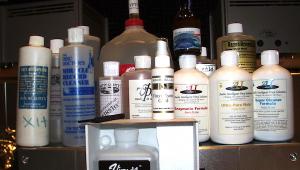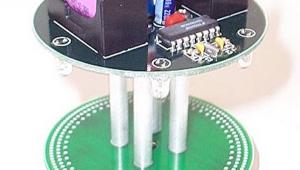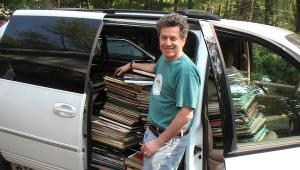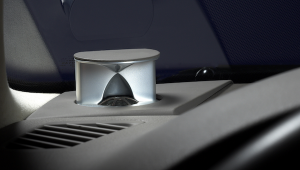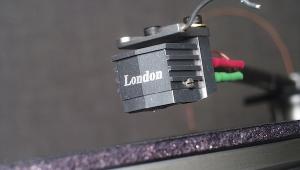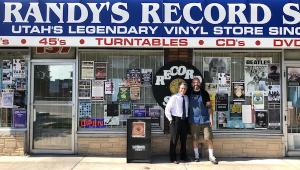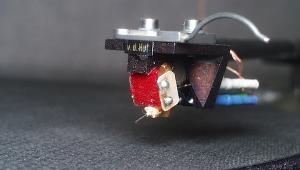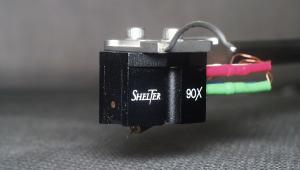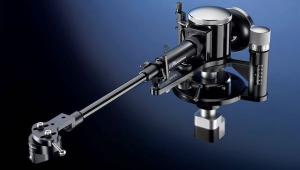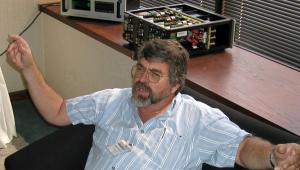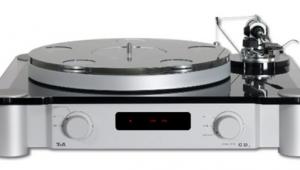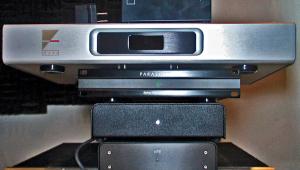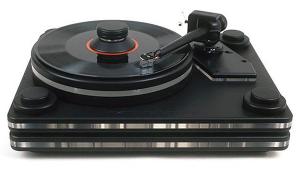Analog Corner #92

I'll spare you my retort, but it included supermarkets, seats, steering wheels, and $10,000 Hyundais, of which one could own 24 for the price of James Bond's latest set of wheels.
I was picking up a V12 Vanquish for a three-day spin through Scotland. Linn had built the car's Hyundai-priced ($10,000) sound system, and my job—my job, if you could call it that—was to review that system. Oh, lucky day...
Not that I hadn't prepared half my life for this assignment. What other Stereophile writers (other than former owner-publisher Larry Archibald) have rebuilt their own car engines? I have. I bored out the Saab (actually, Ford) V4's block, milled the heads, opened the exhaust ports, added a two-barrel manifold and Weber carb, and totally re-did everything myself, from the firewall forward: brakes, suspension, you name it (even if you can't). (Actually, a machine shop performed many of those steps, but I put it all back together.) The result actually ran—and pretty damn fast for an engine that's still used to run industrial sump pumps. It was still running more than a decade later, but I finally sold the car, ending a 27-year love affair. I still pine for it.
Funny thing: I went to a press conference recently for the DVD release of Men In Black II, with director Barry Sonnenfeld in attendance. I'd always wondered why they'd used an old Saab 96 in Throw Momma from the Train, for which he'd been the director of photography, so during the Q&A I asked him. "I used to have one of those—British racing green," he said, misty-eyed. "I regret to this day that I sold it."
"Me too," I replied. "Same color."
I'm probably one of two Jews outside of Tel Aviv who's done his own car work, and I'm proud of it. I mention this to establish my credentials and my right to spend most of three days driving this rocket sled around the lochs of Scotland.
That may sound defensive, but you wouldn't believe people's reactions when I told them I was about to, or had driven, this car. I've had some cool experiences in this job: reviewing mega-priced gear I could never afford to own, visiting factories in exotic places, perusing a plasma television factory for Stereophile Guide to Home Theater. To those, people usually react with something like "Wow, that's cool." Their reaction to this assignment was, more often than not, a scowl followed by a hearty "Eff You!" I'm serious. Just yesterday, I got that from my dentist.
Where the Rubber Leaves the Road
Arriving at Heathrow in mid-November after an all-night flight, I was whisked away in a Passat by Linn's spinmeister, Brian Morris, to a posh London hotel for a day's shuteye. I don't care what travel experts say about staying awake to minimize jet lag—I needed serious mattress time to prepare for the next day's adventure.
That night, Brian "I like to walk" Morris led me on a marathon march through rain-soaked Chelsea, first to visit the Linn department at Harrod's, and then, after many shots of stomach-warming antifreeze at various pubs along the way, for dinner at Chutney Mary's. The food was superb, but I barely tasted it: visions of the Vanquish danced in my head. Next morning, we set off for the Aston Martin factory before dawn to beat the awful London traffic.
At Ford-owned Aston Martin, there's no assembly line per se. Like many limited-production high-end audio companies, AM builds Vanquishes in small quantities (10 per week), the cars being moved from section to section. Body parts are pounded by hand on a special tool in one location, chassis shells are composite-glued (no welding) in another, the leather is cut and the seats assembled in yet another. Each body panel gets eight coats of meticulously applied and buffed paint before it's attached to the car. The pace is slow, the work painstaking. For $240k, you should expect perfection.
Workpeople sign off on each task; if there's a problem, the culprit can be identified and sent off to GM (GM own Saab, so no indignant letters, please). Finished Vanquishes are pulled at random and sent to a special area where a quality-control fanatic checks every seam and stitch to make sure it conforms to the company's exacting standards. Hand-built, $240,000, fully loaded Vanquishes are crash-tested front and rear, just like $10k Hyundais. While touring the facility, I was hoping I'd be able to drive off and not crash the test car, in which, for three days, I'd be driving on the wrong side of the road.
Finally, it was my turn in the passenger seat of a moving Vanquish. And I do mean moving.
A professional driver was assigned to show me the ropes, and with him behind the wheel, we left the factory parking lot. I admired the car's dramatic black-on-white instrument cluster, the rugged, brushed-aluminum dash with clown-red Start button and subtle, engraved Linn logo. I smelled and felt the rich, enveloping leather seats with one hand while running the other across the smooth suede headliner. The windshield view revealed the shapely curves of the familiar Aston nose rising gracefully on either side of the hood line—this long-legged beauty was waiting just for me.
A rare straightaway on a country road allowed the driver to take the 4100-lb cruiser from 30 to 130mph in about three seconds. We then stopped and, as we waited for various body parts to catch up, he explained the Up and Down paddle shifters mounted on either side of the steering wheel, which actuate the automatic/manual six-speed transmission, the torque and handling characteristics (a bit of understeer, and some oversteer at higher speeds), and what I should never do: accelerate sharply with the wheel turned, which could cause the rear end to give way and send the car into a dangerous spin; or leave the car stationary while in first gear—instead, shift to neutral. The driver didn't say what would happen if I left the car in first for a long time while stopped at a light, but I bet it wouldn't smell too good. Finally, it was my turn to get behind the wheel and drive.
Wow. And gulp—with the car's electric system on and the engine off, I pulled both paddles forward simultaneously to put the car in neutral—a big N appeared in the dashboard's gear LED readout and the Start button lit up, letting me know all was ready. A push of Start and vaahROOM—a deep, enormous roar engulfed the rear of the car. Who needs a $10k sound system when you can hear that, I thought. Later, I found that hearing this baby start from outside is twice as exciting as from inside.
Having driven only manual transmissions was a big help—the Vanquish will roll back on hills like a "manual manual," until you hit the gas and the clutch engages. No problem. I took to the wrong side of the road like a pro, with lorries sliding by on the other side seemingly inches from the bumped-out rear-wheel wells. I took her up to around 4000rpm, hit the Up paddle, and the car shifted smoothly into the next gear. I popped the Down paddle and the computer did the old heel-and-toe for me, catching the revs before smoothly downshifting. For $240k, you should feel in control, and I did. I could stomp down on the accelerator in any gear and the engine would roar into action, the G forces melting me into the seatback and sending a healthy surge of adrenalin through my system. Behind the wheel of this car, I was king of the world.
A few hundred feet from the factory gate on my maiden voyage and Boing—Skrape! I'd relaxed, allowing my instincts to take over, and the car had drifted to the left and kissed the curb. Damn! I pulled into the lot, wondering how much damage I'd caused, but fortunately it was just a touch of wheel grind. Embarrassing, but not fatal.
Before letting Brian "where the hell are my keys?" Morris drive the car from the lot and onto the motorway so I didn't have to deal with clockwise roundabouts and confusing right turns, I loaded Linn's six-disc, trunk-mounted CD changer. Linn had gotten involved in the sound-system project after the initial body shell design had been completed. It uses a control unit and preamp borrowed from Jaguar, which, like Aston Martin, is owned by Ford. Spend $240k and you still have to stop, get out, and load the trunk changer when you want to switch discs. Hardly Bond-like. Next time, maybe there'll be an in-dash CD slot. Hyundais probably have 'em...
I brought CD-Rs made from the Rockport turntable and the Boulder phono section (but none using both), as well as a few commercial discs—gold Mobile Fidelitys and DCCs as well as JVC XRCDs. I also snuck in a compilation containing all of the theme songs from the James Bond flicks' original soundtracks, as well as an Italian instrumental album of big-band Bond arrangements. As we got ready to bid adieu to our Aston Martin hosts, I hit Play and out of the speakers poured the familiar "dum da da dum dum, dum dum..." theme. It embarrassed the hell out of Morris, which made it twice as mirthful for me.
Listening on the Road
Once we were on the motorway, I counted the miles until the first rest stop, where we'd switch and I'd finally have a chance to really take the Vanquish for a spin. The car is gorgeous and dramatic-looking, but, unlike some of the Italian competition, its appearance is neither gaudy nor exaggerated. It didn't turn heads on the crowded highway, and that's good—you don't want to feel as if you're in a fishbowl. But the drivers who knew what it was nodded approvingly.
At first, the Linn sound system sounded underwhelming, but that's because I was so used to "car stereo" sound. I wasn't prepared to hear the subtleties of high-end sound in a moving car. Once I'd grown accustomed to it, I realized how accomplished and transparent the system was, despite its complexity. Twelve trunk-mounted 75W amplifiers in a single, sleek, vertically mounted chassis drive 12 loudspeakers (four three-way modules that look like Linn Komris) with modular three-way active crossovers. Each module includes 130mm (mid) 24mm (HF), and 13mm (super HF) drivers crossed over at 100Hz (from the subwoofer), 2.4kHz, and 12kHz, respectively. The servo-controlled subwoofer is powered by its own 200W RMS amplifier.
Integration with the Global Positioning System navigation and phone system resulted in a seamless electronic package. The kind of person buying this car will not want to fiddle with tweaky audiophile stuff.
While Morris got his rocks off behind the wheel, I auditioned the sound system. Davey Spillane's "Atlantic Bridge" offers a true test of deep, powerful bass—if anything in my arsenal would rattle the Vanquish's system, it would be that track. It didn't. Instead, there was deep, tight, powerful, pitch-perfect bass that didn't reverberate around the car's interior and didn't excite loose-fitting panels, windows, or other interior trim. The car was as tightly put together as it handled. Beyond the surprisingly smooth and seemingly flat frequency balance—no car-stereo "boom-tizz"—the system produced a remarkably stable, forward-sounding soundstage. There are two speaker modules mounted in the doors, fairly low down, and another pair on the "package shelf" under the rear window (the subwoofer's there too), and our knees blocked the sound, which should have limited HF dispersion—yet the soundstage appeared in front of me with outstanding lateral balance.
When I later spoke with Linn designer Bill Miller, he told me that the sound system fudges the midrange separation somewhat to achieve that result. Whatever they did, Morris's knees didn't pull the balance my way, and my knees didn't pull it his way. I could adjust the subwoofer level electronically from one of the system menus, but I found that Flat was the preferred setting almost all of the time. The CD-R of Basie Jam that I'd brought, recorded off Analogue Productions' 180gm vinyl reissue, sounded very similar to what I hear at home, timbrally, spatially, and dynamically.
Overall, the system was easily the most accomplished car stereo I've heard: so well-balanced, transparent, and free of distortion that I could easily understand how the dumb twit at Newsweek could report that he didn't think much of the sound when he got a chance to drive the car. It's a sweet-sounding system that any audiophile would be happy to own. Now let me drive, okay?
Finally, a rest area. Morris decided to park as far away from the crowds as possible, so we pulled in to a parking space. When we got out, we saw that the front air-dam was clearing the curb by about a millimeter. Yikes. Had the curb been an inch higher, we'd have done some serious scraping. Heads turned as we walked away from the Vanquish—two graying geezers in black leather jackets and shades. We could almost hear the pair watching us: "What a lovely looking couple! I wonder which is the rich one?"
My Turn
Finally, I took the monster out onto the motorway, accelerating through the gears. Oh, what a feeling—and that's not spelled t-o-y-o-t-a. I was up to 90mph before I could say "I think I've soiled myself."
But all was not well. I was doing 90mph in the rightmost lane of the left side of a crowded six-lane highway. In my peripheral vision I saw three lanes of speeding, oncoming traffic on the right—precisely the opposite of what, for decades, my brain has been wired to see. I was flipped, and there I was driving a $240,000 car with a particularly thick "A" pillar.
Fortunately, the Vanquish's rear-corner "blind spots" are well covered by the mirrors; still, changing lanes was kind of weird. The experience was a combination of exhilaration, power, and serious discomfort. But when the darkness and rain hit, and the headlights speeding by on the right side of the rain-slicked highway began blinding me, it wasn't long before I was worn out. At the next rest area, I let Brian drive the rest of the way to Glasgow, knowing I'd have a day's drive around the lochs on Saturday.
The Linn Factory
Friday's schedule featured a tour of the Linn factory, just outside Glasgow. Linn began as a turntable company almost 30 years ago, with the Sondek designed by founder and president Ivor Tiefenbrun, who now has "MBE" tacked onto his name. Analog been berry berry good to Ivor! (See the November 2002 issue and John Atkinson's roundup of the most important products of the last 40 years for the story of how the Sondek changed audio.)
Linn's factory vibe was similar to Aston Martin's: small by big-company standards, large by small-company standards. Work is done in sections; people have to sign off on what they do as products are constructed, and almost nothing is outsourced. It was easy to see why the AM folks saw Linn as a particularly good fit for the Vanquish's sound system.
Linn's growth over the past three decades has been remarkable. During my visit, I saw a new wing of the Richard Rogers–designed factory being built. As Linn has moved into higher-tech products and production techniques such as surface-mount technology, some have felt the company has lost touch with its audiophile roots. They've seen Linn go from point-to-point wiring to circuit boards with big resistors to circuit boards with small resistors to surface-mounting and switch-mode power supplies—by which point, for them, somehow the soul of hi-fi had been forced out.
Yet during my visit to Linn, a few things were apparent that made that alleged move away from the High End seem only apparent—particularly the company's heavy commitment to R&D. Linn has a full-time engineering staff of more than two dozen people, of a total workforce of 300—an impressively high percentage. During my visit, I saw a new surround-sound processor being designed from scratch, as well as a universal SACD/DVD-Audio/DVD-Video player from which Linn will offer an OEM universal chipset.
What I didn't know about Linn until my visit was how vertically integrated and self-sufficient its manufacturing is. Linn stuffs its own surface-mount boards, and even makes and powder-coats its own component chassis. All parts machining for Sondek turntables is done in-house, including the tonearms, and while the production area devoted to turntables has shrunk considerably as the company has grown, Linn is still devoted to their manufacture. Speaker cabinets and drivers are outsourced, but all design and testing are done from within.
Linn's CD12 CD player ($20,000) is built from the ground up by Linn, including the transport and chassis, the latter milled from a solid block of aluminum. It might be more economical to outsource some of these parts, but Linn feels customers who buy its premium products demand a certain high level of quality that the company can provide only from within. Linn does use outsourced parts in its less expensive lines; the combination lets the company compete at a wide variety of price points, sonically and aesthetically. My tour of the Linn factory left me impressed by the company's engineering prowess and its manufacturing capabilities. But more than that, there was a well-oiled vibe there that I could see and feel.
Late in the afternoon, after losing and finding his cell phone for the umpteenth times, Brian Morris ushered me into the listening room to hear the unorthodox Komri loudspeakers ($40,000/pair) driven by a wall's worth of Linn Klimax power amplifiers as well as their own built-in powered subwoofers. I played the same stack of CDs I'd auditioned in the Vanquish and was not surprised by the similarity of the two systems' basic tonal balances. However the Komris may have measured in Stereophile's review last April, their sound was well-controlled, smooth, and revealing. It was a system that took well to being cranked; I turned it way up and had a blast. Only the bass told me the wrong things—too much of it, and kind of lumpy—but it sounded as if more careful setup of the subs might have solved the problem. All in all, I was impressed by the system's sound.
I'll Always Have Loch Lomond...
Saturday dawned at last. Once safely outside teeming Glasgow, Brian Morris pulled the Vanquish over and I took the wheel. We spent the better part of the day tearing up the winding two-lane roads along dramatic Loch Lomond, the mountains descending from the sky and reaching down into the water. A more dramatic setting in which to enjoy driving that car I couldn't have imagined. The low-to-the-ground Vanquish hugged the twisting asphalt as I'd hope it would, responding happily to my subtlest whim and my most brazen demand. Passing slower cars on the winding roads was a lark. On the rare long straightaways, a tap of the Down paddle and a twitch of the accelerator sent the car hurtling down the road at ridiculous speeds. But then it got dark and began to rain. I knew my dream drive was over. Morris took over and we reluctantly drove back to Glasgow.
That final evening in Scotland, we joined Ivor Tiefenbrun and a friend for an evening of modern dance. Watching guys in bulging tights (bigger bulges than I could fill them with) and anorexic women cavorting around a stage is not usually my idea of a good time, but the George Piper Dancers won me over with their athleticism, ingenuity, and good humor. At the conclusion of the last piece—a representation of a boxing match in which two dancers perfectly expressed the emotions of a fight without ever pantomiming any actual boxing movements—I erupted in applause and cheers as if I was at a rock concert.
Then it was dinner, wine, and lots of laughs at a great restaurant in the heart of a town in which every Saturday night is a lot more raucous than New Year's Eve in New York City. And finally to bed, visions of the Vanquish still shifting gears through the asphalt of my mind.
Sidebar: In Heavy Rotation
1) Low, Trust, Kranky LPs (2)
2) Beth Gibbons & Rustin Man, Out of Season, Go Beat import LP
3) The Soft Boys, NEXTDooRLAND, Matador LP & bonus 45
4) The Who, My Generation: Deluxe Edition, Polydor import LPs (2)
5) Count Basie, Basie Jam, Analogue Productions 45rpm 180gm LPs (2)
6) Dolly Varden, Forgiven Now, Diverse 180gm import LP
7) The Streets, Original Pirate Material, Atlantic LPs (2)
8) Grey De Lisle, Home Wrecker, Hummin'bird 180gm LP
9) Pete Townshend, Scoop, Eel Pie/Classic 200gm Quiex SV-P LPs (2)
10) Otis Rush, Mourning in the Morning, Sundazed 180gm LP
